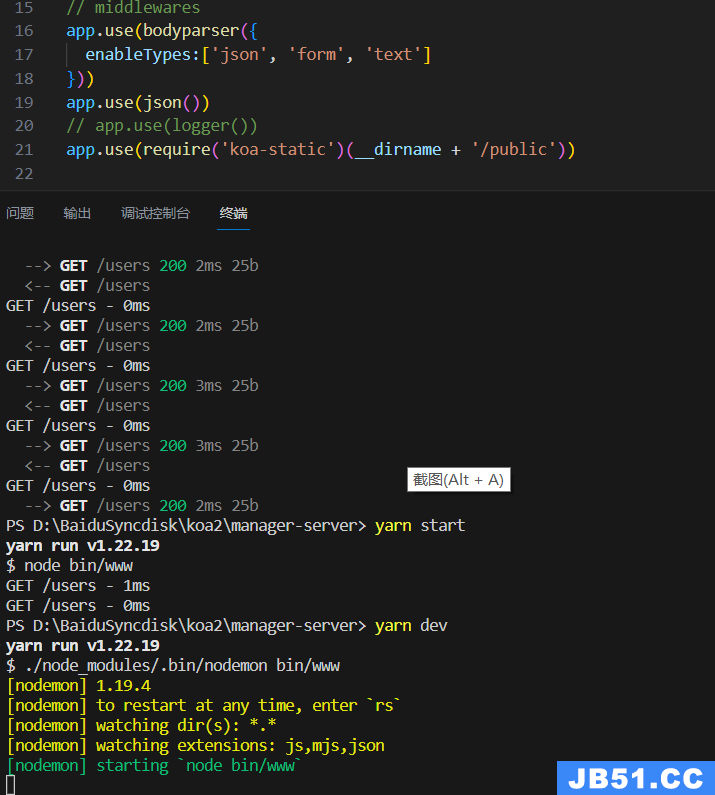详解vue mint-ui源码解析之loadmore组件
本文介绍了vue mint-ui源码解析之loadmore组件,分享给大家,具体如下:
接入
官方接入文档mint-ui loadmore文档
接入使用Example
html
rush:xhtml;">
ottom-method="loadB
ottom" :b
ottom-all-loaded="allLoaded" :max-
distance="150"
@top-status-change="handl
etopChange" ref="loadmore">
<div slot="top" class="mint-loadmore-top">
<span v-show="topStatus === 'pull'" :class="{ 'rotate': topStatus === 'drop' }">↓</span>
<span v-show="topStatus === 'loading'">Loading...</span>
<span v-show="topStatus === 'drop'">释放更新</span>
</div>
<ul class="scroll-wrapper">
<li v-for="item in list" @click="itemClick(item)">{{ item }}</li>
</ul>
css
rush:css;">
*{
margin: 0;
padding: 0;
}
html,body{
height: 100%;
}
app{
height: 100%;
overflow: scroll;
}
.scroll-wrapper{
margin: 0;
padding: 0;
list-style: none;
}
.scroll-wrapper li{
line-height: 120px;
font-size: 60px;
text-align: center;
}
js
rush:js;">
实现原理解析
布局原理
- loadmore组件内部由三个slot组成,分别为name=top,name=bottom,default;
- top用于展示下拉刷新不同状态展示的内容,初始设置margin-top为-top的高度来将自己隐藏
- bottom同top,用于展示上拉加载更多不同状态展示的内容
- default填充滚动详细内容
实现原理
- 主要是通过js的touch事件的监听来实现
- 在touchmove事件,如果是向下滑动并且滚动的dom的scrollTop为0,那么整个组件向下偏移(滑动的距离/比值)展示出top solt的内容
- 在touchmove时间,如果是向上滑动并且滑动到了底部,再继续滑动整个组件向上偏移(滑动的距离/比值)展示出bottom solt的内容
源码解析
组件的template html
rush:xhtml;">
ottomDropped}" :style="{ 'transform': 'translate3d(0,' + translate + 'px,0)' }">
ottom" v-if="b
ottomMethod">
ottomStatus === 'loading'" class="mint-loadmore-spinner" :size="20" type="fading-circle">
ottomText }}
关于 上面的spinner标签,是一个组件,这里不做详细介绍。top solt和bottom slot中的内容是展示的内容,可以通过外部自定义的方式传入。
其实它的实现有一个很严重的弊端,就是写死了top solt和bottom slot的高度为50px,而且js中的处理也是使用50px进行的逻辑处理。所以并满足我们开发中自定义top slot 和bottom slot的需求。
js核心解析
- props解析:关于props的解析,可以参考mint-ui的官方文档
- data解析
rush:js;">
data() {
return {
translate: 0,// 此变量决定当前组件上下移动,scrollEventTarget: null,// 滚动的dom节点
containerFilled: false,// 当前滚动的
内容是否填充完整,不完成会
调用 loadmore的回调
函数
topText: '',// 下拉刷新,
显示的文本
topDropped: false,// 记录当前drop状态,用给组件dom
添加is-dropped class(
添加回到原点的动画)
b
ottomText: '',// 上拉加载更多
显示的文本
b
ottomDropped: false,// 同topDropped
b
ottomreached: false,// 当前滚动是否滚动到了
底部
direction: '',// touch-move过程中,当前滑动的方向
startY: 0,// touch-start 起始的y的坐标值
startScrollTop: 0,// touch-start 起始的滚动dom的 scrollTop
currentY: 0,// touch-move 过程中的 y的坐标
topStatus: '',// 下拉刷新的状态: pull(下拉) drop(释放) loading(正在加载数据)
b
ottomStatus: '' // 上拉加载更多的状态: 状态同上
};
}
上面的关于每个data数据的具体作用通过注释做了详细说明。
watch解析
rush:js;">
watch: {
topStatus(val) {
this.$emit('top-status-change',val);
switch (val) {
case 'pull':
this.topText = this.topPullText;
break;
case 'drop':
this.topText = this.topDropText;
break;
case 'loading':
this.topText = this.topLoadingText;
break;
}
},b
ottomStatus(val) {
this.$emit('b
ottom-status-change',val);
switch (val) {
case 'pull':
this.b
ottomText = this.b
otto
mpullText;
break;
case 'drop':
this.b
ottomText = this.b
ottomDropText;
break;
case 'loading':
this.b
ottomText = this.b
otto
mloadingText;
break;
}
}
}
上面是组件通过watch监听的两个变量,后面我们能看到他们的改变是在touchmove事件中进行处理改变的。它的作用是通过它的变化来改变top slot和bottom slot的文本内容;
同时发出status-change事件给外部使用,因为可能外部自定义top slot 和bottom slot的内容,通过此事件来通知外部当前状态以便外部进行处理。
核心函数的解析
这里就不将所有的method列出,下面就根据处理的所以来解析对应的method函数。
首先,入口是在组件mounted生命周期的钩子回调中执行init函数
rush:js;">
mounted() {
this.init();// 当前 vue component挂载完成之后,执行init()
函数
}
init函数:
{
if (this.scrollEventTarget === window) {
this.containerFilled = this.$el.getBoundingClientRect().b
ottom >=
document.documentElement.getBoundingClientRect().b
ottom;
} else {
this.containerFilled = this.$el.getBoundingClientRect().b
ottom >=
this.scrollEventTarget.getBoundingClientRect().b
ottom;
}
if (!this.containerFilled) { // 如果没有填满
内容,执行loadmore的操作
this.b
ottomStatus = 'loading';
this.b
ottomMethod();//
调用外部的loadmore
函数,加载更多数据
}
});
}
}
init函数主要是初始化状态和事件的一些操作,下面着重分析touch事件的回调函数的处理。
首先touchstart事件回调处理函数
rush:js;">
handl
etouchStart(event) {
this.startY = event.
touches[0].clientY; // 手指按下的位置,用于下面move事件计算手指移动的距离
this.startScrollTop = this.getScrollTop(this.scrollEventTarget); // 起始scroll dom的 scrollTop(滚动的距离)
//下面重置状态变量
this.b
ottomreached = false;
if (this.topStatus !== 'loading') {
this.topStatus = 'pull';
this.topDropped = false;
}
if (this.b
ottomStatus !== 'loading') {
this.b
ottomStatus = 'pull';
this.b
ottomDropped = false;
}
}
主要是记录初始位置和重置状态变量。
下面继续touchmove的回调处理函数
rush:js;">
handl
etouchMove(event) {
//确保当前touch节点的y的位置,在当前loadmore组件的内部
if (this.startY < this.$el.getBoundingClientRect().top && this.startY > this.$el.getBoundingClientRect().b
ottom) {
return;
}
this.currentY = event.
touches[0].clientY;
let
distance = (this.currentY - this.startY) / this.
distanceIndex;
this.direction =
distance > 0 ? 'down' : 'up';
// 下拉刷新,条件(1.外部传入了刷新的回调
函数 2.滑动方向是向下的 3.当前滚动节点的scrollTop为0 4.当前topStatus不是loading)
if (typeof this.topMethod === 'function' && this.direction === 'down' &&
this.getScrollTop(this.scrollEventTarget) === 0 && this.topStatus !== 'loading') {
event.preventDefault();
event.stopPropagation();
//计算translate(将要平移的距离),如果当前移动的距离大于设置的最大距离,那么此次这次移动就不起作用了
if (this.max
distance > 0) {
this.translate =
distance <= this.max
distance ?
distance - this.startScrollTop : this.translate;
} else {
this.translate =
distance - this.startScrollTop;
}
if (this.translate < 0) {
this.translate = 0;
}
this.topStatus = this.translate >= this.top
distance ? 'drop' : 'pull';// drop: 到达指定的阈值,可以执行刷新操作了
}
// 上拉操作,判断当前scroll dom是否滚动到了底部
if (this.direction === 'up') {
this.bottomreached = this.bottomreached || this.checkBottomreached();
}
if (typeof this.bottomMethod === 'function' && this.direction === 'up' &&
this.bottomreached && this.bottomStatus !== 'loading' && !this.bottomAllLoaded) {
event.preventDefault();
event.stopPropagation();
// 判断的逻辑思路同上
if (this.maxdistance > 0) {
this.translate = Math.abs(distance) <= this.maxDistance
? this.getScrollTop(this.scrollEventTarget) - this.startScrollTop + distance : this.translate;
} else {
this.translate = this.getScrollTop(this.scrollEventTarget) - this.startScrollTop + distance;
}
if (this.translate > 0) {
this.translate = 0;
}
this.bottomStatus = -this.translate >= this.bottomdistance ? 'drop' : 'pull';
}
this.$emit('translate-change',this.translate);
}
上面的代码逻辑挺简单,注释也就相对不多。
重点谈一下checkBottomreached()函数,用来判断当前scroll dom是否滚动到了底部。
= document.body.scrollHeight;
} else {
return this.$el.getBoundingClientRect().b
ottom <= this.scrollEventTarget.getBoundingClientRect().b
ottom + 1;
}
}
经过我的测试,上面的代码是有问题:
当scrollEventTarget是window的条件下,上面的判断是不对的。因为document.body.scrollTop总是比正常值小1,所以用于无法满足到达底部的条件;
当scrollEventTarget不是window的条件下,上面的判断条件也不需要在this.scrollEventTarget.getBoundingClientRect().bottom后面加1,但是加1也不会有太大视觉上的影响。
最后来看下moveend事件回调的处理函数
0) {
this.topDropped = true; // 为当前组件
添加 is-dropped class(也就是
添加动画处理)
if (this.topStatus === 'drop') { // 到达了loading的状态
this.translate = '50'; // top slot的高度
this.topStatus = 'loading';
this.topMethod(); // 执行回调
函数
} else { // 没有到达,回调原点
this.translate = '0';
this.topStatus = 'pull';
}
}
// 处理逻辑同上
if (this.direction === 'up' && this.b
ottomreached && this.translate < 0) {
this.b
ottomDropped = true;
this.b
ottomreached = false;
if (this.b
ottomStatus === 'drop') {
this.translate = '-50';
this.b
ottomStatus = 'loading';
this.b
ottomMethod();
} else {
this.translate = '0';
this.b
ottomStatus = 'pull';
}
}
this.$emit('translate-change',this.translate);
this.direction = '';
}
}
总结
- 下拉刷新和上拉加载更多的实现原理可以借鉴
- getScrollEventTarget()获取滚动对象,getScrollTop()获取滚动距离,checkBottomreached()判断是否滚动到底部;这三种方式可以借鉴
- 缺点: 写死了top slot 和 bottom slot的高度,太不灵活;这个地方可以优化
以上就是本文的全部内容,希望对大家的学习有所帮助,也希望大家多多支持编程之家。

